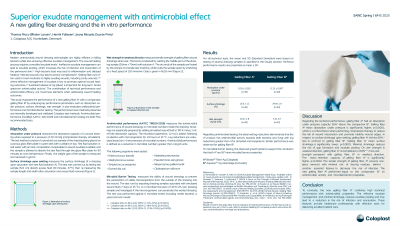Laboratory Research
(LR-037) Superior Exudate Managemeng with Antimicrobial Effect - A New Gelling Fiber Dressing and the in Vitro Performance
Friday, May 2, 2025
7:45 PM - 8:45 PM East Coast USA Time

Thomas Ricco Ølholm Larsen, PhD, M.Sc. (chemical engineering) – R&D Senior Scientist, Coloplast; Henrik Fallesen, MSc – R&D Senior Scientist, Coloplast
Introduction: Modern antimicrobial wound dressing technologies are highly effective in killing bacteria while also ensuring efficient exudate management. This study evaluates the performance of a new gelling fiber A* with a comparator gelling fiber B# key performance parameters such as: absorption under pressure, surface shrinkage, wet strength. Also evaluates antibacterial performance and microbial barrier testing.
Methods:
Tests were performed at Coloplast (Denmark).
Results:
For all technical tests, the mean and SD (Standard Deviation) were based on testing of several dressing samples (n specified in the results section).
Technical performance results are presented as mean ± SD.
Regarding antimicrobial testing, the observed log reductions demonstrate that the A* product has antimicrobial activity towards both bacteria and fungi with log reductions greater than 4 for all tested microorganisms. Similar performance was observed for gelling fiber #B.
On microbial barrier testing, the observed growth patterns support the conclusion that A* and B# have microbial barrier properties.
Discussion:
Gelliing Fiber A* mean absorption under pressure is significant higher, p< 0.0001. Gelling fiber A* mean surface shrinkage is significantly lower, p< 0.0001. Gelling fiber A* mean retention capacity is significant higher, p< 0.0001.
To conclude, the new gelling fiber A# combines high technical performance with antimicrobial properties. The effective exudate management and minimal shrinkage, reduce exudate pooling and may lead to a reduction in the risk of infection and maceration.
Methods:
Tests were performed at Coloplast (Denmark).
Absorption under pressure
Surface shrinkage upon wetting
Wet strength in weakest direction
Antimicrobial performance (AATCC TM100-2019)
Microbial Barrier Testing
Results:
For all technical tests, the mean and SD (Standard Deviation) were based on testing of several dressing samples (n specified in the results section).
Technical performance results are presented as mean ± SD.
Gelling Fiber A* | Gelling Fiber B # | |
Absorption under pressure (g/cm2) | 0.18 ± 0.015 (n=30) | 0.13 ± 0.007 (n=20) |
Surface shrinkage (%) | 13.8 ± 1.1 (n=30) | 34.4± 1.9 (n=24) |
Wet strength (N/20 mm) | 10.1± 1.8 (n=30) | 3.3± 0.7 (n=35) |
Regarding antimicrobial testing, the observed log reductions demonstrate that the A* product has antimicrobial activity towards both bacteria and fungi with log reductions greater than 4 for all tested microorganisms. Similar performance was observed for gelling fiber #B.
On microbial barrier testing, the observed growth patterns support the conclusion that A* and B# have microbial barrier properties.
Discussion:
Gelliing Fiber A* mean absorption under pressure is significant higher, p< 0.0001. Gelling fiber A* mean surface shrinkage is significantly lower, p< 0.0001. Gelling fiber A* mean retention capacity is significant higher, p< 0.0001.
To conclude, the new gelling fiber A# combines high technical performance with antimicrobial properties. The effective exudate management and minimal shrinkage, reduce exudate pooling and may lead to a reduction in the risk of infection and maceration.

.jpg)